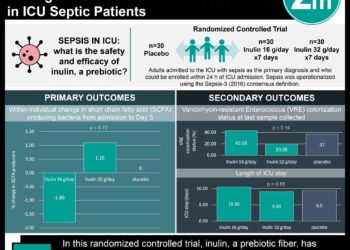Net fluid balance not associated with hospital readmission rates among sepsis patients
1. There was no association found between positive fluid balance at the time of discharge and readmission at 30 days post-discharge in non-critically ill patients hospitalized for sepsis.
Evidence Rating Level: 2 (Good)
Study Rundown: Evidence suggests that the administration of intravenous fluids in patients hospitalized for sepsis is associated with lower mortality. Conversely, other studies have shown that excess fluid administration may be harmful and could lead to adverse events in the hospital or after discharge. This retrospective cohort study investigated whether there was an association between intake and output net fluid balance (I/O) at discharge and readmission at 30 days in patients hospitalized for sepsis. Among 57 032 patients with sepsis outside of the intensive care unit during the study period, 40 940 (71.8%) had positive I/O, and 16 092 (28.2%) had negative I/O at discharge. Baseline characteristics between these two cohorts differed significantly across many factors (see below). For example, patients with negative I/O were sicker according to LAPS2 and COPS2 scores. There was no significant difference in 30-day-all-cause readmission between patients with positive versus negative I/O after adjustment for all significantly different characteristics; in hospitalized septic patients, the net fluid balance was not associated with a higher likelihood of readmission within 30-days of discharge. Notably, positive I/O was associated with increased mortality at 30 days compared to negative I/O. One limitation of this study, however, is unreliable fluid intake measures due to documentation issues and the challenge of determining accurate intravascular fluid balances. Thus, further studies are needed in order to investigate strategies for optimal fluid management of non-critically ill septic patients.
Click to read the study in JAMA Network Open
Click to read an accompanying editorial in JAMA Network Open
Relevant Reading: Fluid resuscitation in septic shock: the effect of increasing fluid balance on mortality
In-Depth [retrospective cohort]: This multi-center (21 hospitals across Northern California) study assessed 57 032 (mean age: 73.7 years) adult patients hospitalized with sepsis from January 1, 2012, to December 31, 2017. Patients admitted to the intensive care unit were excluded. Patients with positive I/O (40 940; 71.8%) and negative I/O (16 092; 28.2%) differed significantly across demographics, including history of kidney and heart disease, sickness scores, and other characteristics, which were all adjusted for in the analysis. The primary outcome was hospital readmission at 30-days post-discharge. Secondary outcomes included stratification of readmission categories and mortality within 30-days of discharge. Two-thousand seven hundred twenty out of 16 092 patients (16.9%) with negative I/O, and 5999 out of 40 940 patients (14.7%) with positive I/O were readmitted within 30-days of discharge (HR: 1.00 [95% CI: 0.95-1.05]). Among all patients post-discharge, the positive I/O cohort resulted in fewer heart failure-related readmissions (HR: 0.80 [95% CI: 0.71-0.91]) and more infection-related readmissions (HR: 1.20 [95% CI: 1.09-1.33]) compared to the negative I/O cohort. In total, there were 3536 (8.6%) patients with positive I/O and 1254 (7.8%) patients with negative I/O who died within 30 days of discharge (adjusted HR: 1.23 [95%:1.15-1.31]; p= 0.001).
Image: PD
©2021 2 Minute Medicine, Inc. All rights reserved. No works may be reproduced without expressed written consent from 2 Minute Medicine, Inc. Inquire about licensing here. No article should be construed as medical advice and is not intended as such by the authors or by 2 Minute Medicine, Inc.







